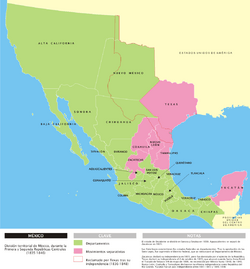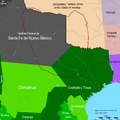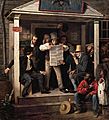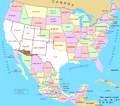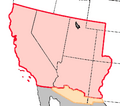Mexican–American War facts for kids
Quick facts for kids Mexican–American War |
|||||||||
|---|---|---|---|---|---|---|---|---|---|
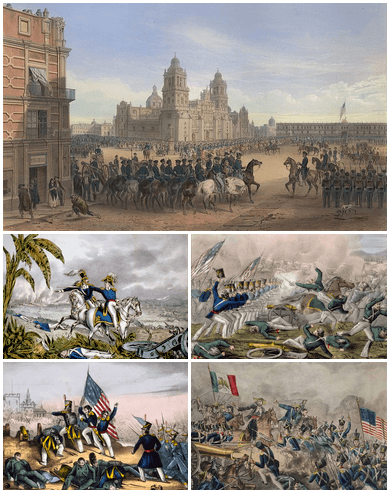 Clockwise from top left: Winfield Scott entering Plaza de la Constitución after the Fall of Mexico City, U.S. soldiers engaging the retreating Mexican force during the Battle of Resaca de la Palma, American victory at Churubusco outside Mexico City, U.S. Marines storming Chapultepec castle under a large American flag, Battle of Cerro Gordo |
|||||||||
|
|||||||||
| Strength | |||||||||
| 73,532 regulars and volunteers | 70,000 regulars 12,000 irregulars |
||||||||
| Casualties and losses | |||||||||
| 1,733 killed in battle (1,721 soldiers, 11 Marines, and 1 sailor) 4,152 wounded |
10,000 regulars dead (5,000 killed in battle) | ||||||||
| Including civilians killed by the war's violence and military disease and accidental deaths, the Mexican death toll may have reached 25,000. | |||||||||
The Mexican–American War was a conflict between the United States of America and Mexico. It took place from 1846 to 1848. This war greatly changed the map of North America.
Contents
Why Did the Mexican-American War Happen?
After Mexico became independent from Spain in 1821, the border with the U.S. was unclear. This caused many arguments, especially about a region called Texas.
Texas was once part of Mexico. But many Americans moved there. By the 1830s, more Americans lived in Texas than Mexicans. These Americans wanted to be independent. They fought for their freedom in 1836. They then created the Republic of Texas. However, Mexico still believed Texas was its land.
The United States also wanted Texas. Adding Texas would mean more land and resources. In 1845, Texas officially joined the United States. Mexico refused to accept this. They still claimed Texas was Mexican territory. This disagreement over the border became a major problem. Mexico said the Nueces River was the border. The United States insisted it was the Rio Grande River.
The Border Dispute and Start of War
In April 1846, U.S. and Mexican troops clashed. This happened near the disputed border area. This event is known as the Thornton Affair. A small group of U.S. soldiers met a larger Mexican force. This small fight quickly made tensions much worse. U.S. President James K. Polk then asked Congress to declare war.
Key Leaders and Campaigns
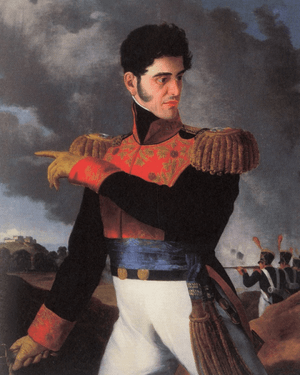
The United States sent two main armies into Mexico. General Winfield Scott and General Zachary Taylor led these armies. Taylor later became a President of the United States.
After the U.S. entered Mexico, Mexican General Antonio López de Santa Anna took command. This was in early 1847. U.S. forces fought Santa Anna near Monterrey and Buena Vista. After the Battle of Buena Vista, the Mexican army faced many issues. These included starvation, disease, and soldiers leaving their posts. The Mexican government was also unstable.
In March 1847, General Scott landed at Veracruz. His force included future Civil War generals. Among them were Robert E. Lee, Ulysses S. Grant, Stonewall Jackson, and George G. Meade. Scott captured Puebla in May. He then took Mexico City in September. This happened after the important Battle of Chapultepec.
Meanwhile, American soldiers also went to California. The Bear Flag Revolt was happening there. Some Californians wanted to leave Mexico. They hoped to form their own country, just like Texas. In July and August 1846, American soldiers captured Monterey, Yerba Buena, and Los Angeles. After some fighting, Americans controlled much of California by 1847. The Mexican governor of California, Pio Pico, left the state.
Important Battles of the War
The Mexican-American War involved many battles. They took place across a huge area. This stretched from the southwestern United States to northern Mexico. Each battle had its own unique story.
- The Battle of Palo Alto (May 8, 1846): This was one of the first big battles. General Taylor's American forces won against the Mexican army. The Americans had better artillery (big cannons!), which helped them a lot.
- The Battle of Resaca de la Palma (May 9, 1846): Just one day after Palo Alto, the Americans won again. This pushed the Mexican army back even further.
- The Siege of Veracruz (March 9 – 29, 1847): General Winfield Scott led a large American force. Their goal was to capture the important port city of Veracruz. This was a long and tough siege. But the Americans eventually won.
- The Battle of Cerro Gordo (April 18, 1847): This was another important American victory. It helped clear the way for the capture of Mexico City.
- The Battle of Chapultepec (September 12–13, 1847): This battle was key to taking Mexico City. The Americans faced strong resistance. But they eventually won.
- The Capture of Mexico City (September 14, 1847): Taking Mexico City was a major turning point. It showed the Americans' strength. It also greatly weakened Mexico's ability to keep fighting.
The Treaty of Guadalupe Hidalgo
The United States won the war. Mexico signed the Treaty of Guadalupe Hidalgo in 1848. This treaty gave the U.S. a lot of land. This land would later become the states of Arizona, California, New Mexico, Nevada, Utah, southwestern Colorado, and southwestern Wyoming. In return, Mexico received 15 million dollars. Mexico also gave up its claims to Texas.
Facts and Figures
- The war lasted from 1846 to 1848.
- About 100,000 American soldiers fought.
- Around 50,000 to 75,000 Mexican soldiers fought.
- About 13,000 American soldiers were killed or wounded.
- Mexican casualties were likely much higher.
Lasting Impact of the War
The Mexican-American War had a huge and lasting impact. It changed the map of North America forever. It also led to big questions in the U.S. about whether slavery would spread into the new lands. These questions later helped cause the American Civil War. This war had many important effects that went far beyond the fighting itself.
Images for kids
-
The 1832 boundaries of Comancheria, the Comanche homeland.
-
Comanches of West Texas in war clothing, around 1830.
-
Mexico in 1824. The border with the U.S. was set by the 1818 Adams-Onis Treaty.
-
Abraham Lincoln in his late 30s. He was a member of the U.S. House of Representatives and opposed the war.
-
Frederick Douglass, an ex-slave and anti-slavery leader, also opposed the war.
-
Henry David Thoreau was jailed for not paying taxes to support the war. He later wrote Civil Disobedience.
-
General Kearny taking New Mexico Territory in August 1846.
-
A copy of the first "Bear Flag" at El Presidio de Sonoma.
-
The Battle of Monterrey (September 1846), from a painting by Carl Nebel.
-
U.S. Army in Mexico City in 1847. The U.S. flag flies over the National Palace.
-
Battle of Churubusco by J. Cameron, 1847.
-
The Mexican Cession (red) and the later Gadsden Purchase (yellow).
-
Second Lieutenant Ulysses S. Grant.
-
A political cartoon about the 1848 presidential election. It refers to Zachary Taylor or Winfield Scott.
See also
 In Spanish: Intervención estadounidense en México para niños
In Spanish: Intervención estadounidense en México para niños


